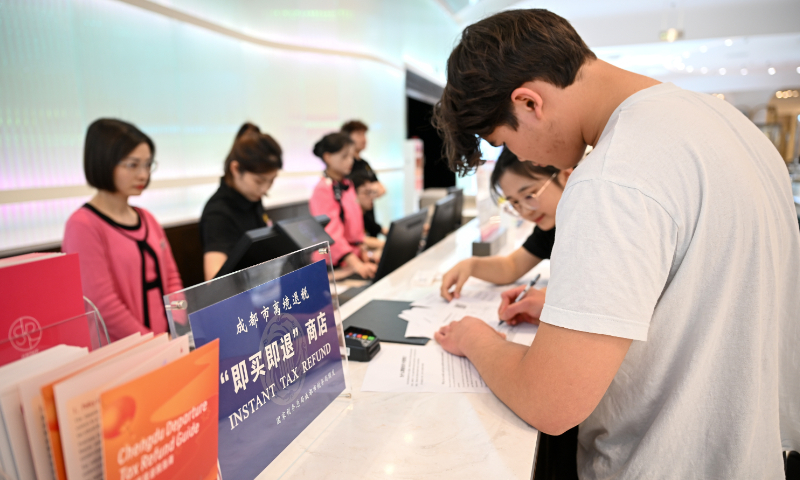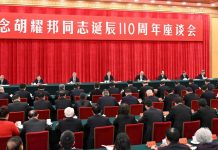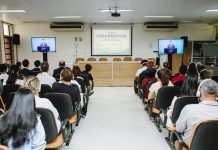BEIJING: “I used to skip tax refunds altogether because I hate waiting in long airport queues. But now, with the instant refund in-store, I actually feel like buying even more cosmetics before I leave [China],” Faiz Rayyan, a student from Malaysia who plans to return to his hometown during the summer holidays, told the Global Times on Sunday.
“I think consumer activity in China is incredibly dynamic,” Anastasia Ivanova, a tourist from Russia, told the Global Times in Beijing while holding a newly purchased toy. “When there’s such a wide variety to choose from and the atmosphere around you is so lively – everyone’s excited and enjoying themselves – it’s really hard to resist buying something you like.”
Since the beginning of this year, riding the wave of the booming “China Travel” trend, the development of “Shopping in China” has also entered the fast lane, buoyed by the optimized departure tax refund policy.
From “China Travel” to “Shopping in China,” the country has effectively converted tourism popularity into increased consumption, promoting the inbound tourism market while demonstrating its commitment to expanding opening-up and meeting the diverse needs of international tourists with high-quality products and improved services, Wang Peng, an associate research fellow at the Beijing Academy of Social Sciences, told the Global Times on Sunday.
“In the first half of this year, nationwide sales under the departure tax refund policy surged nearly 100 percent year-on-year, with the number of departure tax refund stores exceeding 7,200, an increase of about 80 percent compared to the end of 2024. Recently, you may have noticed that in the malls and shopping centers of Beijing and Shanghai, it’s common to see foreign tourists processing departure tax refunds,” He Yadong, a spokesperson from China’s Ministry of Commerce, told a press conference on Thursday.
China began implementing the departure tax refund policy for overseas travelers in 2015. Since then, the scale of departure tax refunds has grown year by year, benefiting an increasing number of overseas travelers, according to the Xinhua News Agency.
On April 27 this year, the country introduced a package of measures to optimize the policy, including measures lowering the minimum purchase threshold for refunds, raising the cash refund ceiling, expanding the network of participating stores, and broadening the range of products covered, said Xinhua.
The country is also promoting a refund-upon-purchase service model, allowing eligible tourists to receive tax refunds instantly at retail outlets rather than waiting until they leave the country.
Starting July 1, Northeast China’s Liaoning Province’s Dalian and 11 cities in Central China’s Hubei Province began to implement the departure tax refund policy for foreign visitors, bringing the total number of such regions to 30.
“Yesterday, an Indian customer received a tax refund of over 2,000 yuan ($277.76) after purchasing a drone,” a sales representative at DJI’s flagship store at the China World Mall in Beijing’s CBD told the Global Times on Sunday. She added that the number of foreign customers has significantly increased since the beginning of the year, with most hailing from the Middle East and India.
Foreign customers primarily purchase high-value items such as drones, primarily for personal or household use, the sales representative said, noting that the tax refund policy makes prices in China more competitive than many overseas channels, attracting many foreign buyers.
“The tax refund process at the China World Mall is standardized and seamlessly integrated with the airport’s app system, which makes it highly convenient. For foreign customers, China’s tax refund experience is efficient and user-friendly,” she noted.
The departure tax refund policy has fostered a virtuous cycle among consumption, services and industry, Wang said. Tax refunds stimulate shopping demand, driving growth in tourism, transportation, accommodation and other service sectors, while pushing domestic manufacturers to improve quality and innovate, creating a dual engine for consumption and industrial upgrading.
“The policy not only activates inbound consumption but also unleashes China’s broader consumption potential by expanding demand, injecting external momentum into the domestic economic cycle,” Wang said.
Diverse supply
As favorites of overseas travelers when shopping in China, sales of domestic mobile phones, smartwatches, drones and other tech products continue to grow, China Media Group (CMG) reported.
“The policy dividends have driven explosive growth in business volume, with electronic products showing especially strong sales performance. In the first half of this year, Shenzhen’s tax refund business maintained strong growth momentum, with sales up 2 times and transactions up 4.3 times year-on-year,” Qiu Minzhao, a researcher at the Shenzhen Commerce Bureau, said in the CMG report.
In addition, cultural and creative products are injecting fresh vitality in inbound consumption.
This summer, the number of foreign visitors to museums across Southwest China’s Sichuan Province noticeably increased. At a departure tax refund store in the Sanxingdui Museum in Guanghan, hundreds of cultural and creative products inspired by Sanxingdui artifacts – such as blind box figurines, divine bird fridge magnets, mask coffee cups, and miniature bronze sacred tree replicas – have captivated foreign tourists, according to CMG.
Since early 2025, the Sanxingdui Museum has introduced over 300 new cultural and creative products, with more than 1,600 tax-refunded items currently available to tourists.
“Overseas travelers can process departure tax refunds at our store for purchases of 200 yuan or more,” Zhou Ni, a staff member at the museum’s cultural and creative store, said in the report.
Wang noted that the global appeal of “Shopping in China” fundamentally stems from the synergy between China’s high-quality manufacturing and services industries. Manufacturing has increased variety, improved quality and built stronger brands, providing high-value-added goods for tax-refunded sales, while the service sector improves the consumption experience through digitalization and standardization.
Moreover, China’s expansion of opening-up is not a passive response to external pressures but a proactive approach to build a global paradigm of “openness-cooperation-upgrading” through expanding demand, upgrading industries and optimizing services. This approach not only activates the endogenous momentum of the Chinese economy but also offers the global market with a dual-engine model of “high-quality supply + high-efficiency services,” injecting certainty into globalization, Wang noted. –The Daily Mail-Global Times news exchange item





